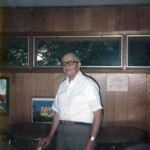My Musical Career
Fred D. Hinger
We have come to the point in this blog where I would like to devote some space to one of the most influential people in my career, namely Fred D. Hinger. Mr. Hinger was my second percussion teacher and perhaps the one who was most influential, both during my college years and for years afterwards.
I first met Mr. Hinger during my freshman year at MSM.I had signed up to take lessons from him and actually took a couple of lessons before it was evident that I needed some basic background lessons before I could understand a word of what he was saying. I therefore took a year of lessons with Jim Preiss, and became a member of Mr. Hinger’s studio at the beginning of my second or sophomore year. He was about 50 years old when I met him – about 5’10 in height, with sandy hair that had become iron gray and a very energetic and enthusiastic manner. He was very friendly without becoming familiar; there was a dignity to the man as well as a gentleness that made him stand out. He had already had a distinguished career as principal percussionist of the Philadephia Orchestra from 1948 until 1951; principal timpanist with that orchestra from 1951 until 1967, and a principal timpanist at the Metropolitan Opera from 1967. He was in his fourth season when I first met him. He was also the founder of the Hinger Touch-Tone Percussion Company, developer of first-class timpani and snare drum mallets and of the Touch-Tone Timpani and later the Touch and Space-Tone Snare Drums. He was also a world class xylophone player and instructor.
Mr. Hinger did not teach at the school during my four years under his tutelage. He preferred teaching in his own private studio, which was set up in the basement of his home at 357 Hilltop Avenue in Leonia, NJ.
To get to his studio, one would have to take the Number 1 Broadway Local of the IRT from the 116th Street station all the way up to 168th Street – take the elevator up to the George Washington Bridge Bus Terminal and take Public Service Bus 163 to Fort Lee/Hackensack. One would ride that all the way across the bridge into and past Fort Lee, and disembark at Glenwood Avenue in Leonia. One would then walk two or three blocks north on Glenwood, then turn right on Hilltop and walk up the hill. His house was on the left – you could enter his studio through the garage – many a day Mr. Hinger would be waiting for you at the open garage and direct you inside himself, or if he was working with a s student, you’d go to the front door and wait in their living room. Mrs. Hinger – Jean was her name would greet you and direct you to the living room sofa to wait your turn. When the previous lesson was finished, Mr. Hinger would come up and greet you with a little small talk – not much and then direct you to the studio.
The Studio
Since I was to spend a lot f time over the next four school years taking lessons from one of the greatest musical minds in the classical percussion world, a brief description of the studio is in order. I mentioned earlier that it was in the basement of his house. It was a space about twenty-six feet in length by about thirteen feet in width and had a stairway that led up into the house and a door to the garage at the rear. It had a pair of sliding doors that led into his yard, and a thin row of windows in the wall above where the timpani were situated. The room contained a full set of timpani – the two inner drums were of the Dresden pedal variety – and the outer drums were generally of the Anheier-cable type, although they were fabricated by Mr. Hinger. When I started lessons on a full time basis in the fall of 1971, he had a pair of older Light Dresdens – what we would call Mark XIs as the inner drums. These timpani were more than a cut above the school’s Ludwigs. They had calfskin heads – other than a quick glimpse of calfskin on a set of Ludwig timpani at West Point back in 1965, this was the first time I would work with calf skin. The timpani were set up against the south wall – there was a music stand in between the inner drums, and another music stand set up as a trap table to the left – this is where we’d put our mallets during our lessons – or he’d have some mallets there for testing and for us to try out. His collection of recordings and record player – this was in the days of the vinyl LP – were off to the left in the corner –and there was sufficient space for him to stand beside us and do his teaching. Behind the timpani and further away from the south wall was a beautiful Deagan marimba which he used for mallet lessons. Like his timpani, he kept this instrument in tip-top shape. A music stand stood behind the marimba, and to the left of it, but out of the way enough to allow one to get back and forth from marimba and timpani was the oddest looking snare drum I had ever seen. It had a shell made of cast iron, with gut snares and Remo Ambassador heads. The drum weighed approximately sixty-five pounds, but it sounded unlike any snare drum that I had ever heard. There were several cabinets full of music in the rear of the studio, and the walls of the studio were paneled. There were also pictures of conductors (autographed) on a couple of the walls. The tile floor was covered by several small rugs. This was Mr. Hinger’s workshop, and I can understand why he preferred to teach her. Admittedly, it was inconvenient for the student, as it took ninety minutes at a minimum to get there from MSM, and there was always the return trip. I made sure that most of my lessons were scheduled in such a way that I did not return to MSM – but went right on to Times Square where I caught the bus home. I didn’t always have to take the bus to Leonia. Whenever Mr. Hinger had a rehearsal that went over or a lesson was scheduled just after a rehearsal ended, he would have me meet him at the Met, and he’d drive me to his home in his white 1968 Volkswagen “beetle”. He was a bit of a cowboy when it came to driving, and I felt that I took my life in my hands whenever I drove with him, but I sensed that he knew how far he could push the envelope and we always arrived at his house without incident, sharing small talk on the way.
One thing I learned early on – never be late for a lesson! There was one time in the middle of my sophomore year when I missed the #163 bus by a minute – I reached the platform just as it was pulling out! The next one wasn’t for a half hour, and this was not the era of the cell phone in which one could call ahead and let the teacher know if you were going to be late, not that this would have made a difference. As it was, I was a half hour late getting there, and Mr. Hinger, though always the gentleman, was not a happy camper. He chewed me out in a quiet but at the same time quite firm manner. I tried to explain out the missed bus and slow train, but he was not having any of it. I was frustrated beyond words and he must have sensed it, because he immediately explained his point in a gentler manner. His point was that if this had been a job, I would have been fired. He counseled me to always leave extra early in order to avoid these kinds of situations. “Better early than late” has been my motto ever since. I am ever grateful to him for caring enough about me to teach me (however firmly) this very important lesson. It was a lesson in how to be professional in behavior as well as in musicianship. That was the essence of the man and his teaching.



Recent Comments